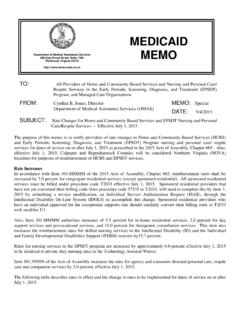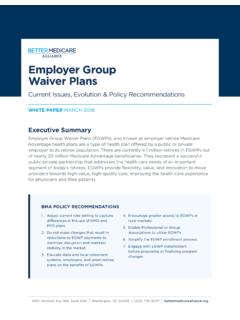Transcription of A 50-State Review of Value-Based Payment Innovation
1 White Paper Value-Based Reimbursement State-by-State A 50-State Review of Value-Based Payment Innovation Commissioned by Change Healthcare Get your own copy of this white paper and exclusive additional research at 2017 Change Healthcare. Please share freely. For reprint rights, please contact us. Value-Based Reimbursement State-by-State 1 Table of Contents Executive Summary.. 4. Introduction .. 5. Methodology .. 7. Defining Value-Based Payment .. 8. How Change Healthcare Can Help .. 9. Commonly Used Acronyms in this White Paper .. 10. State-By-State Summaries .. 11. Alabama .. 12. Alaska .. 13. Arizona .. 14. Arkansas .. 15. California .. 16. Colorado .. 17. Connecticut.
2 18. Delaware .. 19. District of Columbia .. 20. Florida .. 21. Georgia .. 22. Hawaii .. 23. Idaho .. 24. Illinois.. 25. Indiana .. 26. Iowa .. 27. Kansas .. 28. Kentucky .. 29. Louisiana .. 30. Maine .. 31. Maryland .. 32. Massachusetts .. 33. Michigan .. 34. Minnesota .. 35. Mississippi .. 36. Missouri .. 37. Montana .. 38. Nebraska .. 39. Nevada .. 40. New Hampshire .. 41. New Jersey .. 42. New Mexico .. 43. New York .. 44. Value-Based Reimbursement State-by-State 2 North Carolina .. 45. North Dakota .. 46. Ohio .. 47. Oklahoma .. 48. Oregon.. 49. Pennsylvania .. 50. Puerto Rico .. 51. Rhode Island .. 52. South Carolina .. 53. South Dakota .. 54. Tennessee .. 55. Texas.
3 56. Utah .. 57. Vermont .. 58. Virginia .. 59. Washington .. 60. West Virginia .. 61. Wisconsin .. 62. Wyoming .. 63. About Change Healthcare .. 64. Value-Based Reimbursement State-by-State 3 Executive Summary Value-Based Payment : An Innovative and Collaborative Mosaic of Activity Across the Nation Much attention has been paid to the federal government's role in accelerating the shift in healthcare Payment from volume to value . For example, when it announced a commitment to tie 90% of Medicare payments to value by 2018, and 50% of payments to alternative Payment models by 2018,1 the Centers for Medicare & Medicaid Services (CMS) drove other healthcare stakeholders in the same direction.
4 Since then, the CMS has introduced numerous Value-Based programs, and has moved forward implementation of congressionally approved Value-Based Payment initiatives, such as the Protecting Access to Medicare Act of 2014 (PAMA) and the Medicare Access and CHIP Reauthorization Act of 2015. (MACRA). But CMS's role in the Payment reform landscape has overshadowed the importance and momentum of other work occurring at the state level. This report seeks to shed light on this other work through an examination of state-level Value-Based Payment initiatives underway across America. Key findings of this 50-State Review include: 1. More than 40 states have a state-initiated plan or strategy to move toward Value-Based Payment , and almost half of those initiatives are multi-payer in scope.
5 2. Well-developed, Value-Based Payment strategies have been implemented in six states for four years or longer, many with federal support; 23 states have initiatives that are two years or more in implementation; and 10 states are in the early stages of development. 3. As with the federal government, 23 states have established Value-Based Payment targets or mandates that payers and providers agree to achieve. 4. Seventeen states have adopted or are considering adoption of ACOs or ACO-like entities to help manage costs and deliver better care, and 12 states have adopted or are considering adoption of episodes of care programs. 5. Many states have used Value-Based Payment reform to engage with healthcare stakeholders in the redesign of the state healthcare system, identifying unique and innovative strategies that work for their state healthcare market.
6 6. Only seven states have little to no activity around Value-Based Payment . Overall, five states stand out for the breadth of their initiatives, their embrace of Payment models that involve shared risk, and their willingness to test innovative strategies. These states include but are not limited to: Arkansas, which has a multi-payer EOC program in place for five years Colorado, which has a well-developed Medicaid ACO program, and is working with payers and large employers to implement Value-Based Payment Minnesota, which was an early adopter of EOC and has now moved into ACOs Tennessee, which is on pace to roll out 76 episodes of care in its Medicaid and state employee programs by 2019.
7 Washington, which has committed to tying 80% of its state-financed health payments to value by 2021. and is seeking similar commitments from commercial payers in the state Please see the accompanying state-by-state Review matrix for details that support the above assessments. 1 Centers for Medicare & Medicaid Services. Better Care. Smarter Spending. Healthier People: Paying Providers for value , Not Volume. January 1, 2015. Available: Value-Based Reimbursement State-by-State 4 Introduction It has been nearly a decade since Don Berwick and his colleagues at the Institute for Health Improvement introduced the concept of the Triple Aim to the healthcare policy In the article that helped launch the current Payment reform movement, the authors argued that the goal of the health system should be to achieve three interdependent outcomes: improved care for individual patients, improved population health; and reduced costs of care.
8 A central and necessary step to achieving the Triple Aim, they posit, is a shift away from the thinking that more is better and toward better alignment of the Payment system and outcomes. What emerged in years since is a concerted effort among commercial and public payers who, in partnership with providers, are moving away from fee-for-service to Value-Based Payment arrangements. Among public payers, Medicare has taken a leadership role in implementing value - based payments , setting a goal in 2014 of tying 30% of Medicare payments to value by 2016 and 90% by 2018. This goal has led to the rollout of numerous Value-Based Payment initiatives by the CMS. Innovation Center, the creation of the Health Care Payment Learning, and the Health Care Payment & Learning Action Network (HCP-LAN), a public-private partnership aimed at spurring Payment Innovation in the healthcare system at-large, among many other initiatives.
9 Congress also has passed major legislation (PAMA and MACRA) that require Value-Based Payment in Medicare. While Medicare is obviously an influential player in the healthcare system, states retain significant authority over their regional healthcare market and can play a critical role in moving healthcare toward value . Indeed, Medicaid now provides coverage for 20% of the covered lives in the , behind employer- based coverage at 50% but ahead of Medicare at an estimated 14%.3 In addition, individual states have authority over both Medicaid operations and private insurance markets within their jurisdiction. With recent changes to the Medicaid and CHIP Managed Care Rule, states now have the affirmative authority to require Medicaid MCOs in their state to implement Value-Based Payment If they choose to exercise this authority, states have significant power to move their state health insurance markets toward Value-Based Payment reform.
10 Not surprisingly, a Review of state Value-Based Payment reform initiatives demonstrates significant variation in approach, due in part to factors motivating the shift to value . State Payment reform has historically been influenced by factors including state-focused CMS initiatives, state budget challenges, and state policymakers' interest in healthcare Innovation . Two CMS sponsored programs . the State Innovation Model (SIM) grants and the Delivery System Reform Incentive Program (DSRIP) for Medicaid require states as a condition of participation to develop a Payment reform strategy. SIM. grants were released in two rounds beginning in 2013, and in two tracks, known as Design and Test.





